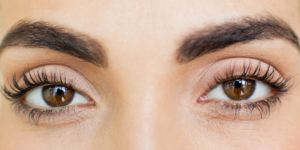
In the US, almost 4.2 million persons who are 40 years of age and older have limited vision or are legally blind. Age-related eye disorders, including cataract, glaucoma, retinopathy, and age-related macular degeneration, account for the majority of blindness and low vision cases in the United States. Other prevalent forms of visual issues include amblyopia and strabismus.
Let’s take a quick look at the top ten most prevalent kinds of eye issues.
Macular degeneration, also called age-related macular degeneration, is an eye disease associated with aging and results in damaging central vision (a vision that is needed for seeing objects clearly and for common daily tasks such as driving and reading). It affects the macula, the central part of the retina that allows the eyes to see even the fine details. There are two forms of macular degeneration, namely wet and dry.
Wet age-related macular degeneration – Wet AMD develops when abnormal blood vessels behind the retina begin to grow under the macula, ultimately causing blood and fluid leakage. Bleeding and scarring from these blood vessels lead to damage and rapid central vision loss.
Dry age-related degeneration– Dry age-related macular degeneration or AMD occurs when the macula thins over time as part of the aging process, gradually blurring central vision. The dry form of macular degeneration is more common and progresses more slowly than the wet form. In such a case, central vision is gradually lost in the affected eye. The dry form generally affects both eyes. One of the most common early signs of the dry form of macular degeneration is drusen (tiny yellow or white deposits under the retina. Drusen are often found in people aged 60 years and older. Numerous drusen increase the risk of developing advanced dry and wet age-related macular degeneration.
Refractive Eye Conditions
Refractive eye conditions include myopia (nearsightedness), hyperopia (farsightedness), presbyopia, and astigmatism (distorted vision at all distances), which is the most frequent eye problem in the United States. These errors can be corrected by eye lenses, eyeglasses, or surgery. According to eye experts, the proper refractive correction could improve vision.
Cataract
A cataract is a clouding of the lens in the eye that affects vision. Most cataracts are related to aging; they are very common in older people. Although treatment for removing cataracts is widely available, a lack of awareness prevents many people from receiving the proper treatment.
Glaucoma
Glaucoma is an ophthalmic neurodegenerative condition characterized by raised intraocular pressure. Patients may experience visual field loss and even lose their vision completely if left untreated. Glaucoma is the second leading cause of eyesight loss globally. With early treatment, one can often protect your eyes against serious vision loss. There are two major types of glaucoma. Open-angle glaucoma is a chronic condition that progresses slowly over time without the person noticing vision loss until the eye condition is at an advanced stage. Angle-closure develops suddenly and is painful. Eyesight loss can progress quickly; however, the pain and discomfort cause patients to seek medical help before permanent damage occurs.
Diabetic Retinopathy
Diabetic retinopathy is one of the most common complications associated with diabetes. It is the major cause of vision loss in adults in the US. The eye condition is characterized by progressive damage to the retina’s blood vessels, the light-sensitive tissue at the back of the eye that is essential for healthy vision. Diabetic retinopathy usually affects both eyes. The risk of this eye condition is reduced through proper disease management that includes adequate control of blood pressure, blood sugar, and lipid abnormalities. Timely diagnosis reduces the risk of vision loss. However, as per CDC (centre for disease control and prevention), as many as 50% of patients are not getting their eyes tested or are diagnosed too late for therapy to be successful. Eye retina problem solutions include laser treatment that treats the growth of new blood vessels at the back of the eye (retina). Discuss with your ophthalmologist to get more brief information regarding the treatment.
Schwizz
An improper alignment of the eyes can lead to strabismus. Although it can happen to adults, reports of it in children are widespread. Your child’s eyes can be pointing in various directions. Additionally, you might observe your youngster tilting their head or closing one eye. This might improve the coherence of your child’s vision. Strabismus comes in various forms, but the most prevalent ones are exotropia, hypertropia, and esotropia. When one or both eyes move inward, it is called esotropia. Hypertropia is the upward turning of one eye. When one or both eyes turn outward, it’s known as exotropia. Most of the time, the reasons are not known.
Amblyopia
Depth perception is either absent or greatly diminished when both eyes are unable to focus on the same image. One eye may develop permanent blindness in that eye as a result of the brain learning to ignore its information.
Xerostomia
Your tear glands can’t create enough tears or the right kind of tears to sufficiently lubricate the surface of your eyes, which leads to dry eye disease. While there are other treatment alternatives, artificial tear plugs or tear duct plugs, which aid in preventing tear outflow, are among the most popular.
How Should Dry Eyes Be Cared For?
Tears in the eyes
When your eyes can no longer hold any more tears, this is what happens. Sensitivity to climatic factors such as sun, wind, temperature fluctuations, and eye infections may lead to the development of the eye ailment. or a tear duct obstruction.
Eye Floaters
These are deposits in the form of clumps that float in the jelly-like material in the center of your eye. Spots or specks that float in the field of vision are the precursors of floaters. They rarely indicate a major eye condition like retinal detachment and are usually benign.
How Can Eye Issues Be Fixed?
Well, eye care professionals examine the eyes and thoroughly test all areas related to the eyes. What could be the answer to your visual issues? The best course of action for maintaining the health of your eyes will be suggested by your eye care professional based on your specific eye condition. Products for treating milder problems including dry eyes and eyes can be purchased online.




